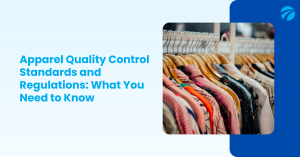Apparel Quality Control Standards and Regulations: What You Need to Know
Apparel quality control is a crucial aspect of the apparel manufacturing process that ensures the products meet the required quality standards. For importers or buyers who outsource or manufacture apparel from abroad, quality control is essential in ensuring that their products meet the required quality standards. In this blog, we will discuss different aspects of apparel quality control, including factors to consider, methods, benefits, standards, and regulations.
Benefits of Apparel Quality Control:
Implementing quality control measures in the apparel manufacturing process has several benefits. Some of these benefits include:
Cost Reduction:
Implementing quality control measures helps to reduce production costs by identifying quality issues early in the production process, reducing the need for rework.
Customer Satisfaction:
Quality control helps to ensure that the apparel products meet the required quality standards and customer expectations, improving customer satisfaction.
Brand Reputation:
Producing high-quality apparel products helps to improve the brand reputation and promotes customer loyalty.
Factors to Consider in Apparel Quality Control:
There are different factors to consider in apparel quality control. Some of these factors include the fabric quality, stitching quality, colorfastness, shrinkage, and garment measurements. Let’s discuss each of these factors in detail.
Fabric Quality:
The fabric quality of an apparel product is crucial in determining its durability, appearance, and feel. Fabric quality is affected by factors such as fiber type, yarn construction, fabric weight, and weave structure. To ensure fabric quality, textile testing is essential. Tests such as fiber analysis,
yarn inspection, and fabric testing are used to determine the fabric quality.
Stitching Quality:
Stitching quality is essential in determining the durability and strength of the apparel product. Poor stitching can result in the garment falling apart, leading to customer dissatisfaction. To ensure stitching quality, various tests are performed, including seam strength testing, seam slippage testing, and stitch density testing.
Colorfastness:
Colorfastness is the ability of the fabric to maintain its color after washing, exposure to light, or rubbing. To ensure colorfastness, colorfastness testing is performed, including washing testing, light testing, and rubbing testing.
Shrinkage:
Shrinkage is the reduction in the size of the garment after washing. It is essential to ensure that the garment retains its original size after washing. Shrinkage testing is performed to determine the amount of shrinkage the garment will undergo after washing.
Garment Measurements:
Garment measurements are essential in determining the fit and sizing of the apparel product. Measuring tape, rulers, and other measuring tools are used to measure the garment dimensions.
Related resources:
Apparel Quality Control Standards and Regulations:

There are different quality standards and regulations in the apparel industry that manufacturers and importers must adhere to. Some of these standards and regulations include:
ISO Standards:
ISO standards are international standards that provide guidelines for
quality management systems. ISO 9001 is a standard that specifies the requirements for a quality management system. Apparel manufacturers and importers can obtain ISO 9001 certification to demonstrate their commitment to quality.
AATCC Standards:
AATCC is an organization that develops testing standards for the textile industry. AATCC testing standards cover different aspects of apparel quality control, including colorfastness, shrinkage, fabric quality, and seam quality.
CPSIA Regulations:
The Consumer Product Safety Improvement Act (CPSIA) is a regulation that sets safety standards for consumer products, including apparel. CPSIA regulations cover different aspects of apparel quality control, including lead and phthalate testing, flammability testing, and labeling requirements.
Tetra Inspection's Expertise in Apparel Quality Control:
At Tetra Inspection, we are well-equipped to handle quality control inspections for apparel. With our network of inspectors located in key exporting cities across Asia, Europe, and Africa, we can provide prompt and efficient service coverage for our clients. We understand the importance of timely and accurate inspection reports, and we strive to provide same-day detailed reports for our client’s convenience.
Our team of highly experienced and professional inspectors is well-versed in apparel quality control standards. When it comes to apparel, we have the expertise to identify potential issues such as stitching defects, fabric flaws, and sizing inconsistencies. We can also ensure that the labeling and packaging of the apparel meet the necessary requirements.
We prioritize the quality of our service and the satisfaction of our clients. With our thorough and reliable inspections, we can help ensure that our clients receive apparel products that meet their standards and expectations.
Contact us to learn more about our customized Apparel Quality Control and how we can help achieve your objectives.


